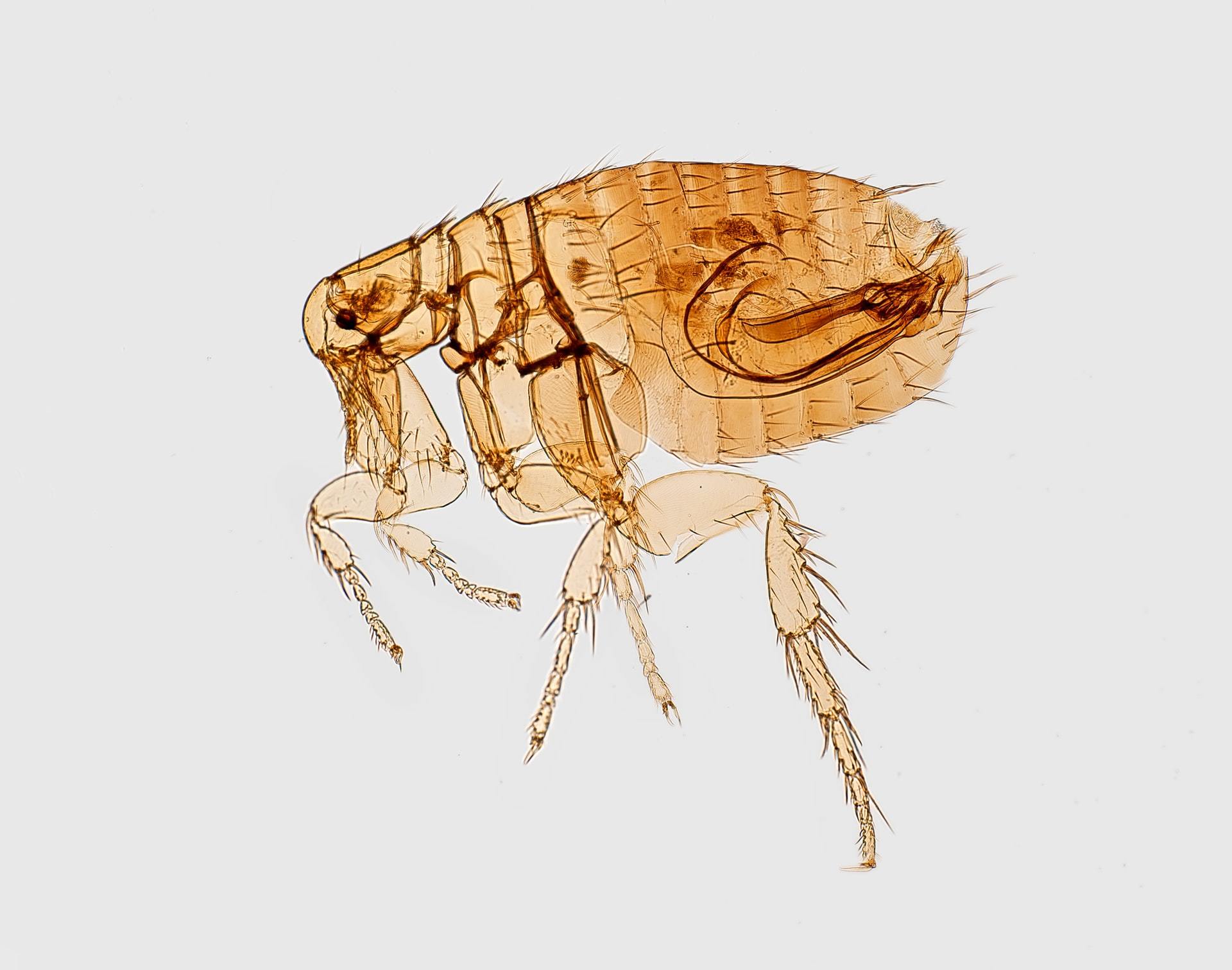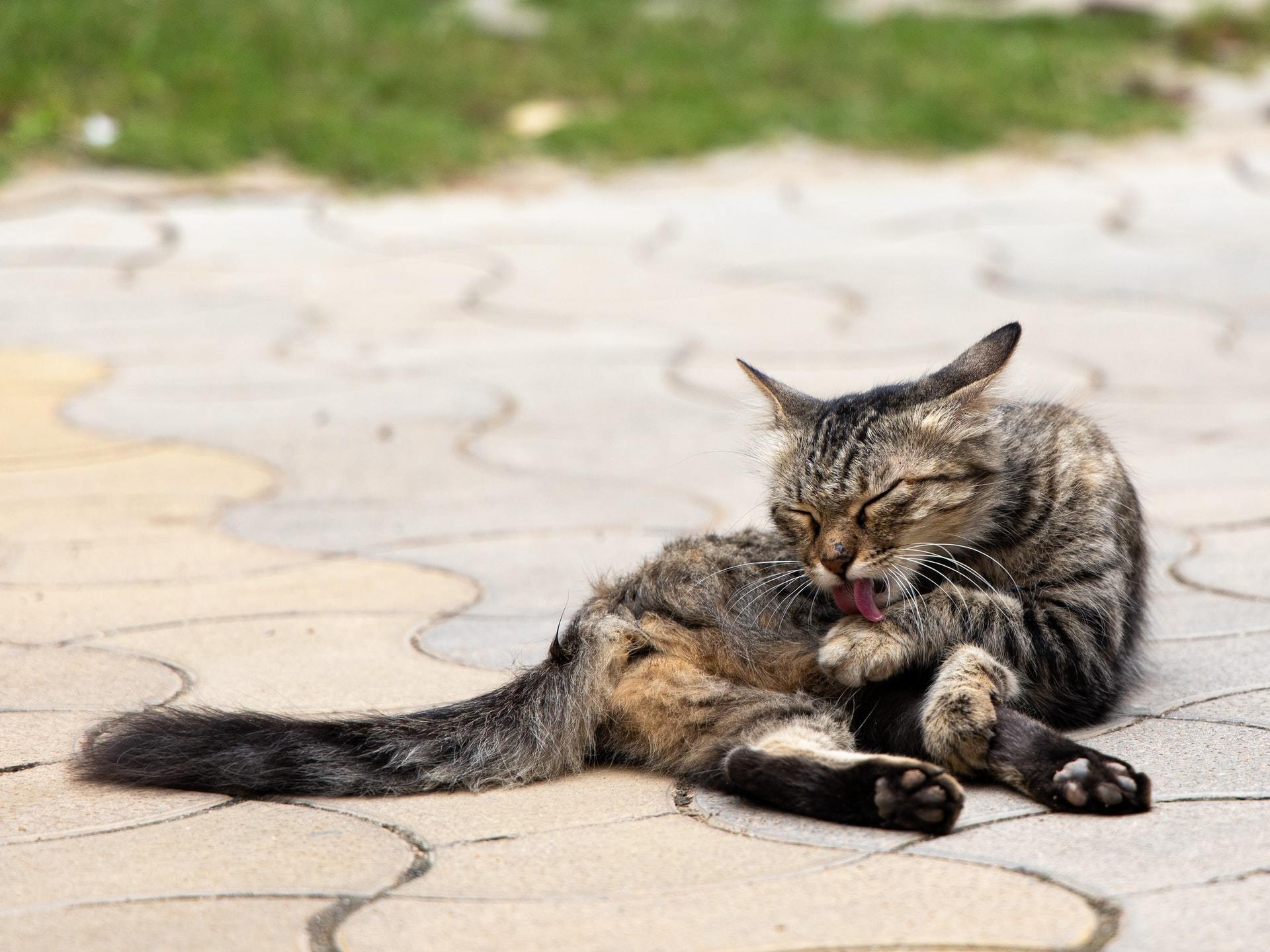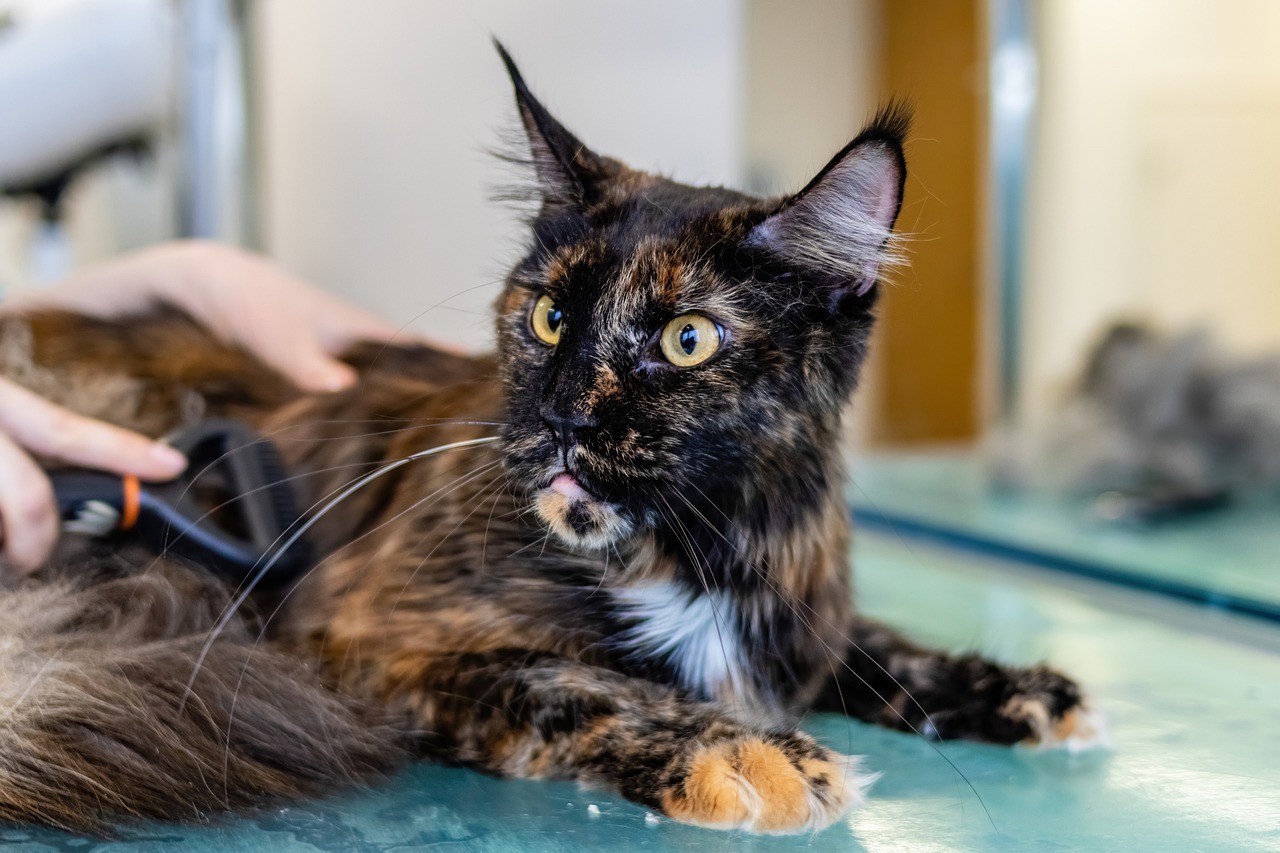Common Skin Problems in Cats

It’s no fun having a cat that is uncomfortable, and skin diseases are a common cause of discomfort. The skin is the largest organ in the body and can respond in a handful of ways to numerous assaults. Keep reading to learn about some of the common skin diseases in cats and what you can do to help your feline friend!
Are you concerned about your pet?
Book a video consultation with an experienced veterinarian within minutes.
- Professional vet advice online
- Low-cost video vet consultations
- Open 24 hours a day, 365 days a year
Dermatitis is a non-specific term that means inflammation of the skin and can have many causes. It can present as problems with hair growth or loss (alopecia), itchiness (pruritis), scabs, sores, rashes, bumps, or a flaking, oily, or smelly coat. Not all skin issues involve inflammation.
Unfortunately, the symptoms are not diagnostic in and of themselves and typically require testing to identify the cause or causes. This is why it is important to have your cat evaluated by a veterinarian. Testing is required to rule out non-issues and identify causes. Diagnostics for most conditions include skin scrapes, cytology, bacterial and fungal cultures, diet trials, allergy testing bloodwork, and skin biopsies.
Causes of Hair Loss (Alopecia) and Itchy Skin in Cats
Fleas
The number one cause of skin problems in cats is fleas. Fleas are not only a pest but can be especially deadly for cats. Fleas carry an organism called mycoplasma and not only can they cause itching, infection, tapeworms, and allergies, they can cause something called flea anemia. I have seen many cats ill with this disease and if left untreated it can be fatal.
I often hear that the pet parent has only seen one or two fleas so it isn’t a problem. Cats tend to be good groomers and eat fleas. Finding even a few fleas or flea dirt can be a sign of an infestation. Indoor cats can also have fleas, especially when living in a high-density situation like an apartment building. If your cat will allow it, bathing with a mild oatmeal shampoo can help remove fleas. A flea comb will also help remove them. Speak with your vet about getting your cat on a good heartworm and flea prevention. The environment may need to be treated professionally and done correctly with daily vacuuming and laundering of bedding.
It is common for me to hear that the pet parent treated their cat with flea prevention, but it didn’t work. There are several reasons that fleas are frustrating. Fleas cannot be eradicated with a single dose of a preventive. Your pet will require long-term, consistent administration of preventives. Additionally, not all flea preventives are made the same. A veterinarian can recommend the most effective preventive for your pet. Other reasons for failure are inconsistent administration, poor quality or inappropriate product, flea allergies, secondary infections, or lack of appropriate environmental treatment.
Common signs of fleas are a thinned coat or hair loss, itching, scabbing especially around the ears or near the tail, flea dirt (flea excrement) which is black dust-like debris in the coat, or bumps.
Typically, your vet will find fleas or flea dirt during the exam which is enough to confirm an infestation. However, there may be secondary issues like mycoplasma, flea allergies, or bacterial infections. This may require blood work, skin cytology, skin scrapes, or intradermal skin testing for allergies to properly diagnose.
Treatment consists of treating the environment and starting and maintaining your pet on an effective heartworm/flea prevention. If your cat has fleas and becomes lethargic, has pale or yellow gums or yellowing of the whites of their eyes or their skin, seek immediate care as these can be signs of flea anemia.

Other Parasites
Fleas aren’t the only parasites that can be a problem for cats. Ticks and mites can also pose problems. Ticks can be removed at the base with tweezers but mites can affect the skin or ears and require diagnosis under a microscope and proper medication from your vet.
Mites often cause hair loss, dandruff, and itching. Most mites in cats are Demodex or Sarcoptes. Demodex is very contagious to other cats and is typically very itchy. Sarcoptes can spread to other cats, dogs, and people. It is extremely itchy. Other less common mites like Cheyletiella tend to cause hair loss and flaking skin but are typically not itchy. These mites are also contagious to other pets. People typically associate mites with the ears but they can appear anywhere.
Mites are typically diagnosed with a skin scrape or treatment trial with specific anti-parasitics containing ivermectin or milbemycin. There are topical and oral formulas. Lime dips by your veterinarian can also help but they can have unwanted side effects, smell bad, and cause staining of the coat as well as furniture once your pet is home.
Bacterial and Fungal Skin Infections
Bacterial infections (pyoderma) are typically caused by Staphyloccocus and are secondary to other causes. These infections are usually itchy, cause redness, scabs, sores, hair loss, and bumps. They can be associated with parasites, allergies, trauma, or a weakened immune system. These infections typically don’t spread to other pets or people but MRSA and other resistant bacteria are possible which can be dangerous to other pets and people.
Ringworm (dermatophytosis) is the most common fungal infection in cats. It tends to occur more frequently in kittens. It is typically itchy but not always. It often causes hair loss in a circular pattern, scaling skin especially on the ears, and is contagious to people and other pets. Be sure to use proper hygiene by wearing gloves and washing your hands and your cat’s bedding frequently. Isolating your cat can reduce transmission of the infection to others.
Skin infections require skin scrapes to rule out parasites, skin cytology, and skin cultures for ringworm. Severe, ongoing, or recurring cases may require allergy treatment. Treatment includes shampoos, topical and oral antibiotics, or anti-fungal medications.
Allergies
Our cats can have allergies to almost anything, just like people. Most commonly cats are allergic to fleas, environmental allergens (atopic dermatitis), or food. Allergies most often present as hair loss, itching, dandruff, bumps, or scabs. Allergens can be air-borne or from contact.
Allergies can be one of the most frustrating issues for pet parents because they can’t be cured, only managed. Diagnosis typically requires ruling out other causes with tests such as a skin scrape, skin cytology, fungal culture, parasite preventive trials, food trials, blood work including thyroid testing, intradermal (skin) testing, blood work to identify other causes, and even biopsy. Treatment can include shampoos, parasite preventives, and steroid or immune suppressants.
Causes of Hair Loss Without Itchy Skin
Behavioral (Psychogenic) or Hyperesthesia
Cats that over-groom have thinned coats, broken hairs, or bald patches (alopecia). This type of hair loss can be the result of itching and any of the causes discussed above, but some cats excessively chew and lick their coats in response to stress or pain. In these situations, the hair loss tends to be on the belly or the back near the tail. This type of over-grooming can lead to sores on the skin (self-trauma).
Hyperesthesia is a dysfunction of the nervous system causing inappropriate nerve pain to otherwise non-painful stimuli. In simpler terms, some cats find light touch painful. These cats tend to become agitated or aggressive when pet on the back or stomach and overgroom the painful areas. They may twitch or hiss at painful areas.
Diagnosis of these conditions can be elusive and is typically obtained when all other conditions have been ruled out. Diagnosing hyperesthesia requires a skin scrape, skin cytology, parasite preventives, blood work, diet trial, and allergy testing as mentioned above but will include identifying possible stress triggers in the environment. Does your cat become agitated when pet? Do they avoid being pet? Possible sources of stress include changes in household routine, visitors coming or owners going on vacation, moving to a new home, overcrowding or new pets, isolation, and territorial issues or stray cats outside that your cat can see and hear.
Treatment includes removing or reducing triggers, pheromone therapy, increased environmental enrichment, and providing adequate or improved access to litterboxes, food, or water.

Endocrine Disease
Hormonal imbalances from endocrine disease can also cause hair loss that doesn’t itch. The primary culprits are hyperthyroid disease and Cushing’s disease (hyperadrenocorticism). Both diseases cause increased thirst and urination, a thin coat, and weight loss. Cushing’s is often concurrent with diabetes mellitus.
Proper diagnosis requires ruling out other causes by skin scrapings, cytology, fungal cultures, and performing additional blood work to test the thyroid and adrenal glands. Thyroid disease treatment involves thyroid medication and/or irradiation of the thyroid gland. Cushing’s disease is much more difficult to manage in cats. Treatment involves surgical removal of adrenal tumors or life-long medication.
Sores, Lumps, and Bumps
Feline Acne
One of the more frequent skin issues that cat pet parents ask about are bumps or black crusting on the chin or around the mouth. This is caused by inflammation of the follicles (folliculitis) and is more commonly called feline acne. It appears to be associated with allergies particularly to plastic food and water bowls and diet. Appearance is typically diagnostic but may involve a skin scrape. Treatment includes replacing plastic food and water bowls with metal or glass bowls, benzyl peroxides, and antibiotics.
Eosinophilic Granulomatous Complex
What a mouthful! These complexes are thought to be associated with allergies and can result in 3 types of skin lesions. They are all caused by the skin being infiltrated with a specific type of white blood cell called an eosinophil. Most of these are not itchy but can have a pronounced appearance.
1. Indolent ulcers, also called rodent ulcers, cause inflammation and erosion of the lips. Cats do not appear to have significant pain but the damage done to the lips is typically progressive and can be permanent.
2. Eosinophilic granulomas, also called linear granulomas, form in long thin strips on the backs of the thighs. These are also thought to be non-painful but can be itchy.
3. Eosinophilic plaques cause the skin to appear very red, hairless, raised, and moist. They can appear severe like burns but do not appear to be especially painful for cats. They often form around the front of the throat and chest but can appear anywhere. These lesions are often diagnosed by their distinct appearance but typically require flea/ mite preventive trials, antibiotics trials, steroid trials, skin biopsy, and skin and blood allergy testing. Treatment involves life-long flea/mite preventives, allergy treatment, or immunosuppressive treatment.
Abscesses
Although not a true skin disease, abscesses can cause a sudden swelling under the skin. These are infections under the skin that can develop quickly, often overnight. Typically, these form from wounds made by claws or teeth when fighting other animals. Oftentimes, these need to be drained and require antibiotics.

Growths and Tumors
There are many causes of growths which may be benign (non-cancerous) or malignant (cancerous). Benign growths can include granulomas, skin tags, or lipomas. Malignant growths most commonly include squamous cell carcinomas, mammary gland tumors (can be benign or malignant), fibrosarcomas, mast cell tumors, and melanomas.
Diagnosis requires fine needle aspirate and biopsy. Oftentimes, your vet will recommend radiographs and surgical removal.
Coat Quality - Oily, Flakey, Matted, or Smelly Coat
As mentioned above, cats tend to be good groomers. When a cat presents with an oily, smelly, or coat full of dandruff it can indicate a problem. Sometimes it is a skin problem but it can also be an indication that your cat isn’t feeling well. It may be due to an underlying illness such as obesity, nutritional problems, or systemic diseases like kidney, hormonal, or liver disease.
Diagnosis includes scrapes, cytology, allergy testing, and additional blood work. Treatment includes weight management, shampoos, topical medications, increased grooming by the pet parent, or medical management. Long-haired cats in particular often need assistance with regular grooming or mats and dandruff can form. When fur mats become tight, they can be painful and damage the skin by cutting off the blood supply. These should be removed very carefully as it is easier than you think to accidentally cut the skin. The best method is prevention by regular brushing.

As you can see, diagnosing skin conditions in cats often requires a bit of detective work. Most skin issues require cytology, scrapes, diet trials, and allergy testing. Blood work and biopsy may be required for certain conditions. Antibiotics and/or steroids aren’t always the answer and can even have adverse consequences like making the problem worse, causing bacterial resistance, or inducing diabetes mellitus or congestive heart failure. Depending on the cause of the skin issue, it may require ongoing management rather than a cure.
The important things to keep in mind are seeing a vet to rule out possible causes and identifying the proper cause, keeping your cat on consistent heartworm/flea prevention, feeding out of glass or metal bowls, reducing stressful triggers, and grooming your cat regularly which can also help create a stronger bond.
Read more:
Common Causes of Itchy Ears in Cats
Need to speak with a veterinarian regarding your cat’s skin problem or another condition?
Click here to schedule a video consult to speak to one of our vets. You can also download the FirstVet app from the Apple App Store and Google Play Stores.
More articles about Cat
Are you concerned about your pet?
Book a video consultation with an experienced veterinarian within minutes.